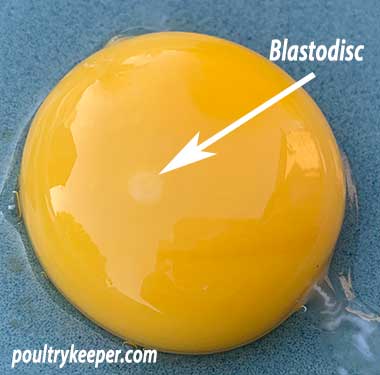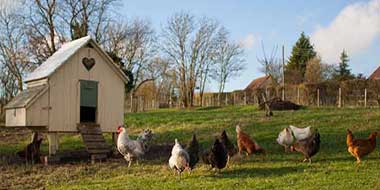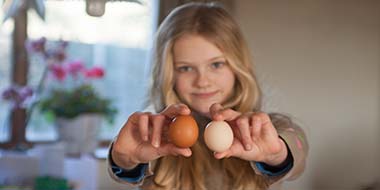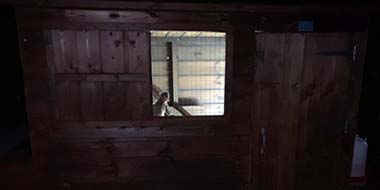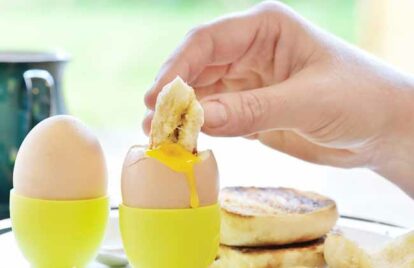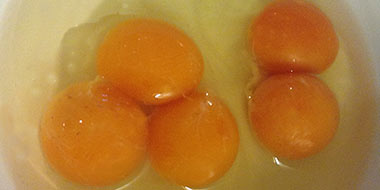
Eggs come in a variety of sizes and are commonly available in almost every country around the world. This article tells you everything you need to know about the insides of an egg which will be useful for understanding the hatching and incubation of eggs or simply for general knowledge about eggs.
The egg is essentially made up of six main parts: the shell, membranes, albumen or white as it is more commonly known, yolk, chalazae (the supporting tissue that ‘holds’ the yolk in the centre of the white) and the germinal disc or egg cell.
The eggshell
The shell is usually more pointed at one end. There is a good reason for this when an egg is laid; if it rolls, it doesn’t roll away too far from the nest because it rolls around in a circle! Not all eggs are like this (the Pekin Duck, for example), but this is a useful feature in the wild, especially if you are a seagull laying your eggs in a nest on the edge of a cliff!
The majority of the eggshell comprises calcium carbonate, hence the need for us to provide a constant supply of calcium through proper nutrition and a good supply of oyster shell grit.
Eggshells can also come in a variety of colours, depending on the breed. There is a chicken eggshell colour chart here.

Shells are porous and during incubation, this allows a certain amount of moisture to evaporate from the egg and also allows oxygen into the egg and carbon dioxide out of the egg for respiration.
One interesting thing about eggs is that their shells are amazingly strong but in the right way. The inside of the shell is softer than the outside which means a little chick is able to break through the shell to get out but is well protected from the outside. This inner layer is also the calcium source that a chick uses to develop bones.
Membranes
There are two membranes: an inner and an outer. The outer membrane is attached to the shell. The inner membrane separates from the outer one at the broad end of the shell as the egg gets older creating the air sack. It is possible to gauge the age of an egg by looking at the size of the air sack. Freshly laid eggs have virtually no air sack. Once they have cooled, the air sack measures about 3mm.
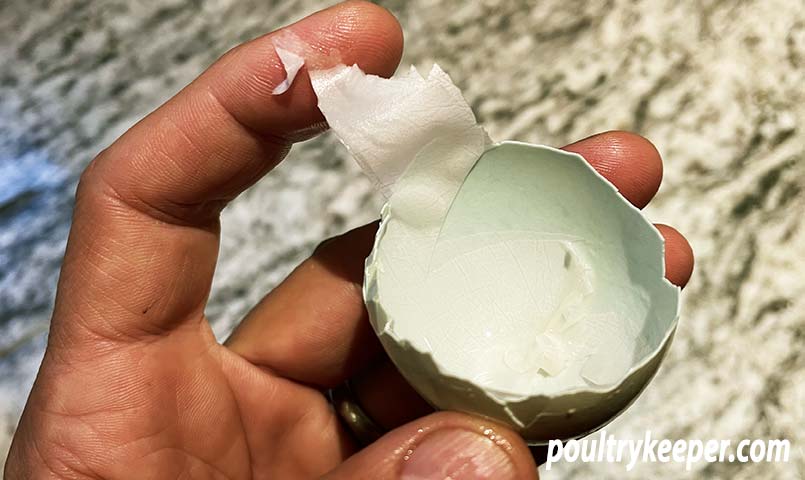
Freshness of eggs
Egg freshness is measured by candling the egg and looking at the size of the air sack. For a Grade A egg in the UK, this must be no more than 6mm.
If your chickens have been laying away from their nest boxes without you knowing, and later, you find them, as well as candling, you can perform an egg float test to estimate their age and check they are still good to eat. Of course, often, this is the first thing I would suggest you check if your chickens stop laying. They might be laying away somewhere!

Albumen (egg white)
The albumen, or ‘white’ as more commonly called, contains water, vitamins, minerals and protein. It has 3 layers: the first, next to the outer membrane, and the last layer, next to the yolk, are ‘watery white’. The middle layer is thicker like a jelly which acts as a shock absorber when the egg is knocked. The yolk floats freely in the inner watery white. The white is the food that is absorbed by the developing embryo in the egg.
Egg yolk
When learning about eggs, one of the major parts we all enjoy for breakfast is, of course, the yolk.
The yolk is made up of water, vitamins, minerals, fats and protein. As well as a tasty meal for us, when incubating an egg, this food is absorbed by the chick through the abdomen before hatching and keeps the chick alive during those first few days of its life.
This is the reason that day-old chicks can be shipped around the country and why chicks can successfully be left to dry out in the incubator without food or water for some hours before removing them to the rearing area.
Chalazae
These are supporting spirals that hold the yolk in place. Each spiral is twisted in the opposite direction to the other.
Germinal disc or egg cell
This is where the male and female cells meet in fertile eggs and start the cell division process.
You can see if an egg has been fertilised if you look carefully at the yolk. There is a blastodisc which appears as a small white spot in unfertilised eggs.
If an egg is fertilised, it appears to have a circular ring around it, making it look like a bullseye, which is called a blastoderm.
And that’s it! You know all about eggs.
